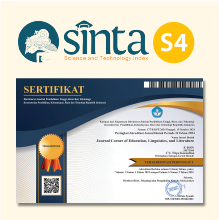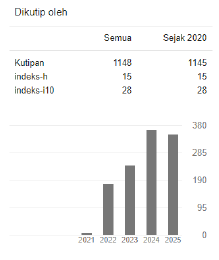The Integration of Islamic Noble Characters and Sundanese Local Wisdom to Realize Modernization of Islamic Education
 https://doi.org/10.54012/jcell.v4i1.307
https://doi.org/10.54012/jcell.v4i1.307
 Abstract views: 432
Abstract views: 432
 PDF downloads: 193
PDF downloads: 193
Keywords:
Islamic education, modernization, noble characters, Sundanese local wisdomAbstract
Education in Islam has three basic concepts consisting of Al-Tarbiyah, Al-Ta’dib, and Al-Ta’lim. The three basic concepts has the main goal to achieve ‘Insan Kamil’. This article aims to identify the integration of Islamic noble characters and Sundanese local wisdom to realize modernization of Islamic education. This study employs qualitative method under descriptive approach. The findings assert that Islamic noble characters framed in the acronym of FAST which is described as Fatonah (intelligent), Amanah (trustworthy), Sidik (honest), and Tablig (the person who delivers the mandate). Meanwhile the Sundanese local wisdom framed in the term of Catur-Sila which is described as Silih Asih (loving each other), Silih Asah (educating each other), Silih Asuh (giving knowledge each other, or teaching each other, or educating each other), and Silih Wawangi (making proud each other). In the context of technology 4.0 era, the integration of Islamic noble characters and Sundanese local wisdom is expected to realize modernization of Islamic education at which every Moslem is able to learn Islam in modern ways which is not only having “Insan Kamil”, but also having 4Cs 21st century skills, i.e.: creative thinking, critical thinking & problem solving, communication, and collaboration.
Downloads
References
Abidin, Z., Ahyar, S., & Wardah, W. (2022). Modernization of Islamic education and Islamic thought in Indonesia. EDUMASPUL: Jurnal Pendidikan, 6(2), 2338–2343. https://doi.org/10.33487/edumaspul.v6i2.4611
Alhafizh, M. F., Effendi, C., Musthofa, R. F., & Najmura, T. A. (2021). Kaitan Silih Asih, Silih Asah, dan Silih Asuh dengan Sila Ke-3 Pancasila Sebagai Ideologi Negara dan Falsafah Negara. Jurnal Kewarganegaraan, 5(2), 671–680. https://doi.org/10.31316/jk.v5i2.1975
Amri, M., Saharuddin, S., & Ahmad, L. O. I. (2019). The Implementation of Islamic Education: The Process of Instilling Akhlakul Karimah (Noble Characters) for Madrasah Tsanawiyah Students. Tadris: Jurnal Keguruan Dan Ilmu Tarbiyah, 4(1), 117–125. https://doi.org/10.24042/tadris.v4i1.4070
Azra, A. (2015). Genealogy of Indonesian Islamic Education: Roles in the Modernization of Muslim Society. Heritage of Nusantara: International Journal of Religious Literature and Heritage, 4(1), 85–114. https://doi.org/10.31291/hn.v4i1.63
Darusman, Y. (2020). Local Wisdom and Environmental Preservation (Study on Sundanese Indigenous People in East Priangan, West Java, Indonesia). Journal of Archaeology of Egypt/Egyptology, 17(8), 453–469. https://archives.palarch.nl/index.php/jae/article/view/3438
Fajrussalam, H., Mansyur, A. S., & Zaqiah, Q. Y. (2020). Gaining Education Character Based on Cultural Sundanese Values: The Innovation of Islamic Education Curriculum in Facing Era Society 5.0. Jurnal Iqra’: Jurnal Kajian Ilmu Pendidikan, 5(1), 104–119. https://doi.org/10.25217/ji.v5i1.910
Fraenkel, J. R., Wallen, N. E., & Hyun, H. H. (2012). How to design and evaluate research in education, eight edition. New York: The McGraw-Hill Companies, Inc.
Hambali, A., Herniawati, A., & Hidayat, Y. (2024). Scope of the Philosophy of Science: A Review of Philosophical Education. Journal Corner of Education, Linguistics, and Literature, 3(3), 231–240. https://doi.org/10.54012/jcell.v3i3.263
Hidayat, Y., Herniawati, A., & Ihsanda, N. (2022). The use of drilling technique to teach English speaking to the early childhoods: A descriptive study. Journal Corner of Education, Linguistics, and Literature, 2(1), 73–80. https://doi.org/10.54012/jcell.v2i1.66
Hidayat, Y., Susanti, V., Muztahidah, D., Hajar, S., & Muslihat, A. S. (2023). Analisis penggunaan media big book dalam mengembangkan kemampuan berbahasa anak usia 3-4 tahun. Al-Urwatul Wutsqo: Jurnal Ilmu Keislaman Dan Pendidikan, 4(2), 40–45. https://doi.org/10.1234/al-urwatul%20wutsqo.v4i2.75
Jackson, E., & Parker, L. (2008). Enriched with Knowledge: Modernisation, Islamisation and the Future of Islamic Education in Indonesia. RIMA: Review of Indonesian and Malaysian Affairs, 42(1), 21–53. https://doi.org/10.3316/informit.181292531365317
Kurnia, R., & Muhajir, A. (2021). Ilomata International Journal of Social Science (IJSS). Ilomata International Journal of Social Science ( IJSS ), 2(2), 118–123. https://doi.org/10.52728/ijss.v2i2.225
Mu’min, U. A. (2023). Construction of Islamic Character Education Values Based on Local Wisdom in Culture Kasepuhan and Kanoman Palaces. Tafkir: Interdisciplinary Journal of Islamic Education, 4(2), 305–318. https://doi.org/10.31538/tijie.v4i2.391
Mufidah, D., Sutono, A., Purnamasari, I., & Sulianto, J. (2022). Integrasi Nilai-Nilai Islami dan Penguatan Pendidikan Karakter. Semarang: Universitas PGRI Semarang Press.
Mulyono, N., Herniawati, A., & Hidayat, Y. (2023). Bedtime Storytelling: A Method to Enhance Early Childhoods’ Language Development. Jurnal Pendidikan Anak Usia Dini Undiksha, 11(3), 61–69. https://doi.org/10.23887/paud .v10i3
Nasir, M. A., Arif, M. F., Safrudin, I., & Sholeh, N. S. M. (2023). The Local Wisdom on Sundanese People in Relationship with the Natural Environment: An Analytical Study of the Philosophy of Society of Kampung Dukuh Garut. KnE Social Sciences, 8(18), 247–255. https://doi.org/10.18502/kss.v8i18.14223
Priyanto, A. (2020). The Refinement on Character education to Strengthening Islamic Education in Industrial Era 4.0. Nadwa: Jurnal Pendidikan Islam, 14(1), 123–128. https://doi.org/10.21580/nw.2020.14.1.5563
Rahmah, S. A. (2020). Implementasi Kearifan Lokal Silih Asah, Silih Asih, Silih Asuh, Silih Wawangi, Silih Wawangi, Silih Wawangi Dalam Membentuk Karakter Peserta Didik. Sosietas: Jurnal Pendidikan Sosiologi, 10(1), 790–800. https://doi.org/10.17509/sosietas.v10i1.26008
Shuhufi, M., & Purkon, A. (2023). Harmonization of Islamic Law and Local Culture: A Study of Indonesian Sundanese Ethnic Culture. Jurnal Ilmiah Al-Syir’ah, 21(1), 138–153. https://doi.org/10.30984/jis.v21i1.1870
Sundari, E. J., Annisa, A. N., & Supartini, N. (2019). The Strengthening of Sundanese Local Wisdom through Literature in Purwakarta Jawa Barat. PROJECT (Professional Journal of English Education), 2(3), 398–403. https://journal.ikipsiliwangi.ac.id/index.php/project/article/view/2912
Sutiana, Y., Muhammad, A., Kahmad, D., & Solihin, M. (2022). Sundanese Muslim Community’s Understanding of Sufism: A Phenomenological Approach. Jurnal Iman Dan Spiritualitas, 2(4), 501–512. https://doi.org/10.15575/jis.v2i4.20811
Suyatno, S., Wantini, W., Sukiman, S., & Rachmawati, Y. (2022). Progressive Islamic Education: Bridging the Gap of Islam, Indonesianness, and Modernity. Qualitative Report, 27(1), 226–242. https://doi.org/10.46743/2160-3715/2022.4782
Woodward, M. (2019). Islamicate Civilization and National Islams: Islam Nusantara, West Java and Sundanese Culture. Heritage of Nusantara: International Journal of Religious Literature and Heritage, 8(1), 148–187. https://doi.org/10.31291/hn.v8i1.542
Yoseptry, R. (2022). The Management of Sundanese Cultural Local Wisdom Learning in developing Early Childhood Nationalist Character. AL-ISHLAH: Jurnal Pendidikan, 14(4), 5035–5050. https://doi.org/10.35445/alishlah.v14i4.1732
Downloads
Published
How to Cite
Issue
Section
License
Copyright (c) 2024 Yusuf Hidayat, Nina Indriana, Ani Herniawati, Adang Hambali, Hasan Basri

This work is licensed under a Creative Commons Attribution-ShareAlike 4.0 International License.
All articles published in the Journal Corner of Education, Linguistics, and Literature are licensed under the Creative Commons Attribution-ShareAlike License (CC BY-SA).

















